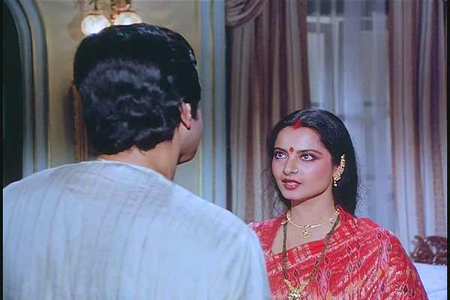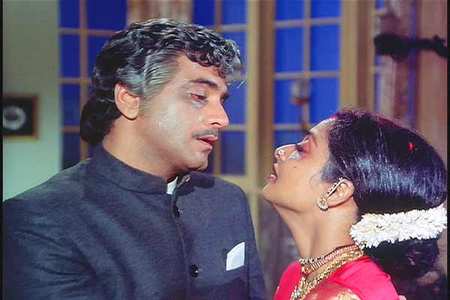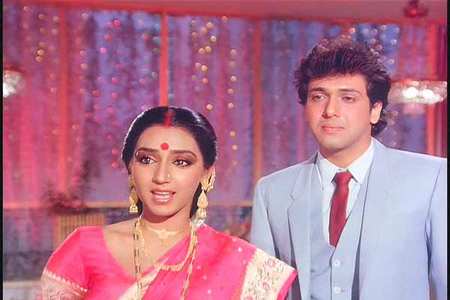Review of Sadhaa Suhagan
Introduction
A movie which showcases a very "cinematic" Indian society as it was seen back in the 1980’s, when youths having a drink and dance at a club were seen as bad, and housekeeping was a housewifes dream. Luckily we have outgrown these closed minded views as audience expectations have told Indian cinema otherwise. Now clubbing is seen as a pasttime in films like Mujhe Kuch Kehna Hai (2001), and a wife has her rightful say in films like Astitva (2000).
Sada Suhagaan is clearly dated and tiring, and can be seen as quite controversial as to what it preaches. Perhaps that is why when viewing this film I felt quite annoyed at the fact that the film preaches instead of telling a story. Personally it isn’t just the films ideology that makes it a bad view. Pitible acting with exception to actors Jeetendra and Rekha, poor screenplay, and typical characters like that of the overweight auntie and her stupid son that cause grievances for their family are all present in this film.
The songs are not melodious and are quite forgettable. Also the background musical score is guilty of trying to get at our emotions with high-strung violins with and music taken from other films like Trishul (1978) and Dewaar (1976). T. Rama Rao, the master of directing social drama such as this during the 1980s provides yet another weak film that is best avoided. Even though his direction is watchable, it isn’t satisfying.
If you want to see a good social drama then view films like Santaan (1996) whose plot is similar to this film. The only difference being that it doesn’t preach, it tells a story of a village man, doing so much for his urban son only to be let down by his sons own selfish views.

Video
The film is presented in its original aspect ratio of 1.33:1, as originaly shot by the filmmakers when first released. The print has been taken from an interpostive 35mm negative which really shines on this disc. The transfer is free from major wear and tear marks, although little blemishes in the form of white and black dots do make a noticeable appearance.
The DVD is free from compression artefacts, film grain, edge enhancement and major shimmering details. What we are left with is very much a cinema quality release of the film, which looks absolutely stunning at times considering the film is over ten years old. The print looks very fresh and clean as a result of the fine encoding work by DEI. Dark details and shadows are are reproduced very well with sharp focus.
Picture information brings out splendid sharpness which reveals everything within the film, from the small text right down to the jewellery detail. Only some minor moiré effects are present but they are never intrusive. The colour saturation is rather bright and bold with many components within it, making it a more cinema like viewing. Colour distortion is found only in two scenes, which show their age with brown hues, but they never distract and are but minor quibbles.

Audio
The Dolby Digital 2ch mono Hindi soundtrack is presented on this DVD as was original recorded. The sound does have some light hissing during subtle scenes and a couple of light crackles can be heard if you’re the kind that turns your volume right up. But the sound does the best it can with a limited mono track and it provides clear and audible sound.

Features
The menus are the usual DEI style animated DVD, and no features are provided. Only the inclusion of well done English subtitles are included.

Conclusion
With this short and unheard of film DEI have fed it the cup of digital life which has continued its lifeform with its now newly found audiences. If intrested in the film then it is worth renting.
Your Opinions and Comments
Be the first to post a comment!